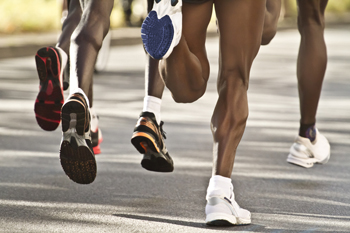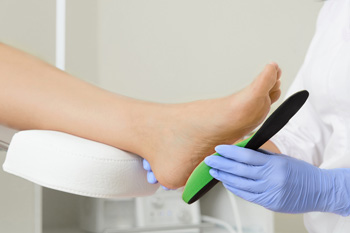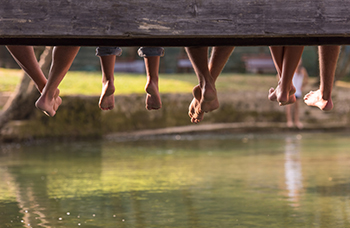Items filtered by date: August 2022
Several Reasons for Poor Circulation in the Feet

Poor circulation in the feet is common among diabetic patients. Acrocyanosis, which is a condition that can affect the extremities, and arteriosclerosis which can be triggered by high blood pressure are other reasons why this condition can develop. Poor circulation in the feet is the result of closed or narrow blood vessels, and patients who have this may be at risk for other health issues. Some of the symptoms that are associated with this condition include hair loss on the feet and legs, and dry or cracked skin. Additionally, people who have poor circulation may have weak toenails, and their feet may feel cold and have a bluish tint. The medical condition known as Raynaud’s disease syndrome may cause the blood vessels in the feet to become narrow, and this can limit the amount of blood that circulates. Additionally, peripheral artery disease (PAD) may contribute to poor circulation. This can cause the inability to feel existing cuts and scrapes that may have developed on the feet as a result of excessive plaque build up in the arteries. If you have poor circulation in your feet for any reason, please contact a podiatrist who can properly diagnose and treat this ailment.
Poor circulation is a serious condition and needs immediate medical attention. If you have any concerns with poor circulation in your feet contact Harvey Jacobs, DPM of Quality Foot Care Center. Our doctor will treat your foot and ankle needs.
Poor Circulation in the Feet
Poor blood circulation in the feet and legs is can be caused by peripheral artery disease (PAD), which is the result of a buildup of plaque in the arteries.
Plaque buildup or atherosclerosis results from excess calcium and cholesterol in the bloodstream. This can restrict the amount of blood which can flow through the arteries. Poor blood circulation in the feet and legs are sometimes caused by inflammation in the blood vessels, known as vasculitis.
Causes
Lack of oxygen and oxygen from poor blood circulation restricts muscle growth and development. It can also cause:
- Muscle pain, stiffness, or weakness
- Numbness or cramping in the legs
- Skin discoloration
- Slower nail & hair growth
- Erectile dysfunction
Those who have diabetes or smoke are at greatest risk for poor circulation, as are those who are over 50. If you have poor circulation in the feet and legs it may be caused by PAD and is important to make changes to your lifestyle in order to reduce risk of getting a heart attack or stroke. Exercise and maintaining a healthy lifestyle will dramatically improve conditions.
As always, see a podiatrist as he or she will assist in finding a regimen that suits you. A podiatrist can also prescribe you any needed medication.
If you have any questions please feel free to contact our office located in Somerset, NJ . We offer the newest diagnostic and treatment technologies for all your foot and ankle needs.
Typical Pregnancy Foot Problems

Although it might not seem immediately intuitive to some pregnant women, pregnancy can seriously impact and affect the feet. While a baby grows inside a pregnant woman, the woman’s center of gravity changes, forcing the feet to adapt. Additionally, during pregnancy, the woman produces a variety of pregnancy hormones that can have significant effects on the feet. One typical problem that you might encounter during your pregnancy is flat feet. Flat feet occur when the feet lose their natural arch and the entire foot presses directly against the ground when standing. Pregnant women can sometimes develop flat feet because as they gain a notable amount of weight, they exert more and more pressure on the feet, which can reduce the arch in the feet. Secondly, another common pregnancy foot problem is swelling in the feet. Swollen feet can frequently occur in pregnant women because, throughout the pregnancy, the pregnant woman’s body must produce a significantly larger amount of blood to support the growing baby. This excess of blood and fluids might sometimes lead to swelling in the feet. As a result, you might notice your foot size increasing, causing your feet to temporarily require larger shoes. If you are pregnant, it might be a good idea to reach out to your podiatrist who can help you manage symptoms on your feet.
Pregnant women with swollen feet can be treated with a variety of different methods that are readily available. For more information about other cures for swollen feet during pregnancy, consult with Harvey Jacobs, DPM from Quality Foot Care Center. Our doctor will attend to all of your foot and ankle needs.
What Foot Problems Can Arise During Pregnancy?
One problem that can occur is overpronation, which occurs when the arch of the foot flattens and tends to roll inward. This can cause pain and discomfort in your heels while you’re walking or even just standing up, trying to support your baby.
Another problem is edema, or swelling in the extremities. This often affects the feet during pregnancy but tends to occur in the later stages.
How Can I Keep My Feet Healthy During Pregnancy?
- Wearing orthotics can provide extra support for the feet and help distribute weight evenly
- Minimize the amount of time spent walking barefoot
- Wear shoes with good arch support
- Wear shoes that allow for good circulation to the feet
- Elevate feet if you experience swelling
- Massage your feet
- Get regular, light exercise, such as walking, to promote blood circulation to the feet
If you have any questions please feel free to contact our office located in Somerset, NJ . We offer the newest diagnostic and treatment technologies for all your foot and ankle needs.
Are You Suffering From Ingrown Toenails?
How Flat Feet Affects Runners
 Flat feet are a condition where the patient exhibits little or no arch in their feet. In other words, every part of the bottom of the foot, also known as the sole, rests entirely against the floor when standing on both feet. An individual can develop flat feet naturally as a matter of genetics, or in response to injury, aging, or pregnancy. Whatever the cause, flat feet can be a headache for runners. If you are running with flat feet, you might experience pain in the feet or knees. This may be caused by overpronation whereby some patients with flat feet excessively roll their feet inward to absorb shocks when walking or running. This possible overpronation can cause muscles in the feet to tighten. Also, flat feet might cause problems when running because the condition increases a runner’s susceptibility to suffering an injury or developing tendinitis. Tendinitis can affect the tendons around the heels and knees, essentially inflaming the tendon, which can lead to pain and tenderness. If you are a runner with flat feet, consider reaching out to a podiatrist who can help you address the problem. A podiatrist may recommend running with orthotics or shoe inserts to correct any possible overpronation.
Flat feet are a condition where the patient exhibits little or no arch in their feet. In other words, every part of the bottom of the foot, also known as the sole, rests entirely against the floor when standing on both feet. An individual can develop flat feet naturally as a matter of genetics, or in response to injury, aging, or pregnancy. Whatever the cause, flat feet can be a headache for runners. If you are running with flat feet, you might experience pain in the feet or knees. This may be caused by overpronation whereby some patients with flat feet excessively roll their feet inward to absorb shocks when walking or running. This possible overpronation can cause muscles in the feet to tighten. Also, flat feet might cause problems when running because the condition increases a runner’s susceptibility to suffering an injury or developing tendinitis. Tendinitis can affect the tendons around the heels and knees, essentially inflaming the tendon, which can lead to pain and tenderness. If you are a runner with flat feet, consider reaching out to a podiatrist who can help you address the problem. A podiatrist may recommend running with orthotics or shoe inserts to correct any possible overpronation.
Flatfoot is a condition many people suffer from. If you have flat feet, contact Harvey Jacobs, DPM from Quality Foot Care Center. Our doctor will treat your foot and ankle needs.
What Are Flat Feet?
Flatfoot is a condition in which the arch of the foot is depressed and the sole of the foot is almost completely in contact with the ground. About 20-30% of the population generally has flat feet because their arches never formed during growth.
Conditions & Problems:
Having flat feet makes it difficult to run or walk because of the stress placed on the ankles.
Alignment – The general alignment of your legs can be disrupted, because the ankles move inward which can cause major discomfort.
Knees – If you have complications with your knees, flat feet can be a contributor to arthritis in that area.
Symptoms
- Pain around the heel or arch area
- Trouble standing on the tip toe
- Swelling around the inside of the ankle
- Flat look to one or both feet
- Having your shoes feel uneven when worn
Treatment
If you are experiencing pain and stress on the foot you may weaken the posterior tibial tendon, which runs around the inside of the ankle.
If you have any questions please feel free to contact our office located in Somerset, NJ . We offer the newest diagnostic and treatment technologies for all your foot and ankle needs.
Are Orthotics Right for Me?

Many people need to wear orthotics in their shoes. They are defined as custom-made insoles that can help a variety of foot conditions and may also be used to improve ankle support. A proper diagnosis can determine if orthotics are right for you. This can consist of having a physical examination performed on the feet, discussing existing symptoms, and checking for painful deformities. Additionally, an X-ray or MRI may be ordered that can show any signs of arthritis or damage to the foot. There are some foot conditions that can alter the foot structure including bunions, hammertoes, heel spurs, or flat feet. There are two categories of orthotics consisting of rigid and flexible and may be available in two sizes, full-shoe inserts or smaller inserts that the heels can fit in. If you have a foot ailment and would like more information about the benefits of wearing custom-made orthotics, it is strongly advised that you seek the counsel of a podiatrist.
If you are having discomfort in your feet and would like to try orthotics, contact Harvey Jacobs, DPM from Quality Foot Care Center. Our doctor can provide the care you need to keep you pain-free and on your feet.
What Are Orthotics?
Orthotics are inserts you can place into your shoes to help with a variety of foot problems such as flat feet or foot pain. Orthotics provide relief and comfort for minor foot and heel pain but can’t correct serious biomechanical problems in your feet.
Over-the-Counter Inserts
Orthotics come in a wide variety of over-the-counter inserts that are used to treat foot pain, heel pain, and minor problems. For example, arch supports can be inserted into your shoes to help correct overarched or flat feet, while gel insoles are often used because they provide comfort and relief from foot and heel pain by alleviating pressure.
Prescription Orthotics
If over-the-counter inserts don’t work for you or if you have a more severe foot concern, it is possible to have your podiatrist prescribe custom orthotics. These high-quality inserts are designed to treat problems such as abnormal motion, plantar fasciitis, and severe forms of heel pain. They can even be used to help patients suffering from diabetes by treating foot ulcers and painful calluses and are usually molded to your feet individually, which allows them to provide full support and comfort.
If you are experiencing minor to severe foot or heel pain, it’s recommended to speak with your podiatrist about the possibilities of using orthotics. A podiatrist can determine which type of orthotic is right for you and allow you to take the first steps towards being pain-free.
If you have any questions please contact our office located in Somerset, NJ . We offer the newest diagnostic and treatment technologies for all your foot and ankle needs.
When Do Feet Stop Growing?

The feet are considered to be the foundation of the body. Their function is to provide stability and balance to the body, in addition to making it possible to stand, walk and run. Children’s feet grow rapidly to keep up with the rest of their bodies, and will grow faster during puberty. As the child approaches adulthood, the bones in the feet become larger, and will continue to grow until the age of approximately twenty. There are 26 bones in each foot, and the bones in both feet add up to one quarter of the bones in the body. An interesting fact is the feet have the most sweat glands per square centimeter, and 125,000 of them are located on each sole. Additionally, the feet have 8000 nerve endings, and this can contribute to the feet being one of the most ticklish areas of the body. Research has indicated that toenails grow slower than fingernails, and a toenail can take 12 to 18 months to fully grow. If you would like to know more about foot structure, and interesting information about the feet, please consult with a podiatrist.
If you have any concerns about your feet, contact Harvey Jacobs, DPM from Quality Foot Care Center. Our doctor can provide the care you need to keep you pain-free and on your feet.
Biomechanics in Podiatry
Podiatric biomechanics is a particular sector of specialty podiatry with licensed practitioners who are trained to diagnose and treat conditions affecting the foot, ankle and lower leg. Biomechanics deals with the forces that act against the body, causing an interference with the biological structures. It focuses on the movement of the ankle, the foot and the forces that interact with them.
A History of Biomechanics
- Biomechanics dates back to the BC era in Egypt where evidence of professional foot care has been recorded.
- In 1974, biomechanics gained a higher profile from the studies of Merton Root, who claimed that by changing or controlling the forces between the ankle and the foot, corrections or conditions could be implemented to gain strength and coordination in the area.
Modern technological improvements are based on past theories and therapeutic processes that provide a better understanding of podiatric concepts for biomechanics. Computers can provide accurate information about the forces and patterns of the feet and lower legs.
Understanding biomechanics of the feet can help improve and eliminate pain, stopping further stress to the foot.
If you have any questions please feel free to contact our office located in Somerset, NJ . We offer the newest diagnostic and treatment technologies for all your foot and ankle needs.

